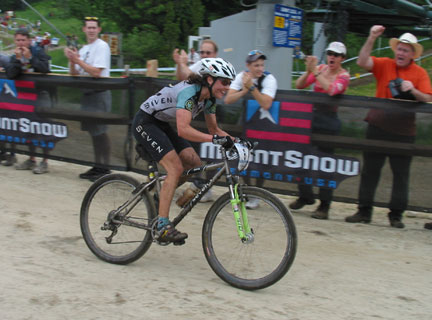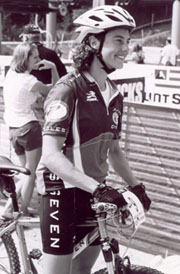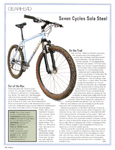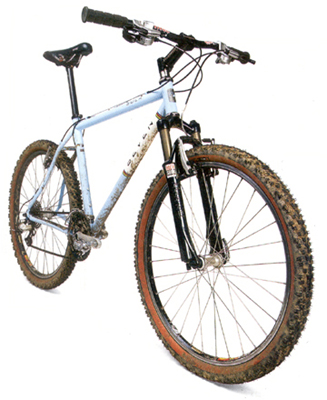by Richard Fries
Photos By Matt O’Keefe

For Mary McConneloug, cycling is not dirge of discipline but a delightful dance. Perhaps that more than anything else is why she’s matured into the best off-road racer on the East Coast.
“I think it’s a soul sport. I love the training; it’s my favorite part,” said McConneloug. “I love riding through the woods on a long epic journey.”
She has no plans to replace a heart rate monitor that broke. She doesn’t know her maximum heart rate. She uses no power measurement device. She has never had a formal coach.
“I’m pretty good at listening to my body,” said McConneloug. “I’m pretty driven; that’s just my character.”
The middle child from a brood of five, she’s never stood out. Recently, however, the bashful McConneloug has had to accept flowers, pop champagne and teach folks how to properly pronounce and spell her name.
For the record, the pronunciation is ma-CON-a-log.
“I better learn how to pronounce her last name,” said Jimena Florit (RLX Polo Sport), the NORBA series champion. At the second Chevy Trucks NORBA National, Florit got a full dose of McConneloug. “(At the) start, during the first lap this girl in a green jersey, cuts off in front of me, like she owns the trail. I thought ‘Who’s thaaaaat?’ It was Mary coming through!”
This elfin rider from California has become the one to watch in both mountain bike racing and especially cyclocross. Having raced just four seasons, McConneloug has become marked by Florit, Alison Dunlap, Alison Sydor, Mary Grigson, Anne Grande and Lyne Bessette.
“I guess I really didn’t think they were watching me. I definitely felt a bit … uh… star struck this year by all the people that knew my name and gave me props,” said McConneloug. “It’s all the attention a middle child could ever want.”
Surprisingly, this West Coast native gives credit to her racing and residing on the East Coast.
“I think my power at the start comes from racing a lot and training. Cross races start off fast because it is an advantage to make as much time possible, as soon as possible, without over extending one’s self…as with mountain biking,” she said. “Racing in New England rocks! The bike culture out here is cool. They get into.”
McConneloug, 31, started racing late in life. She developed a love for the outdoors and a mature sense of balance between her body and soul and then got into racing. Thirty years ago, one might have called her a hippy.
“Cycling is different than other sports in that it often develops a participant’s environmental, social, political and even spiritual awareness. For me, I definitely am conscientious of doing what I can to conserve our planet. I try not to skid out on trails. That wrecks them. I try to ride my bike as transportation to use less gas. I buy eco friendly products and food,” said McConneloug. “I want to have nice places to ride and hike for years to come.”
McConneloug grew up in Marin County. Her father ran a heating and sheet metal business; her mom ran the household with a devotion to natural food. The money all went to Catholic schooling; recreation consisted of camping trips and music. She played soccer for nine years, studied ballet and piano, and played assorted sports. What she loved most, however, was singing. She learned how to write and sing in several languages and graduated from Santa Clara University with a degree in vocal performance in 1993. McConneloug sang the national anthem at her graduation in front of 4,000 people. Oh, and one other thing: she had commuted to school by bike since age 6.
She loved bikes for the purest of reasons. After college she waited tables, went in and out of choirs, but searched for a life out of doors and on her bike. In 1997 she moved to Oregon with a bike racer boyfriend. After one race she forgot everything else. In her first summer she owned the Oregon circuit. She showed up at the 1998 SuperCup in Seattle and took fourth. That convinced her to turn pro in 1999.

Having known only success, McConneloug smacked into reality as a first-year pro. Working full time, she struggled to train, eat, rest and race properly. She carried high hopes for the SuperCup series. In Seattle she reached the podium only to discover her car had been stolen with her wallet and bike inside. Warming up before the Chicago SuperCup, she T-boned a car and broke her bike. She got laid off, broke up with her boyfriend, and retreated back home. This would break most first-year pros.
Back home she rediscovered Marin County as a mountain bike rider. And in May she discovered Michael Broderick, stopping in Marin en route to Big Bear, in front of the local hardware store. They recognized each other from mountain bike races. After a few days of bike rides and beach walks, McConneloug packed everything into his truck. Broderick had to return home to Martha’s Vineyard to work at his family’s ice business, but they agreed to rendezvous at Mount Snow. There he invited her back home. She never left.
Broderick’s skills have also developed. While his mendicant style fits the mountain bike scene, he’s proven a brilliant cyclocross racer with top 10 finishes at several UCI races this season. Both have the temperament of mountain bike racers; they just happen to excel at ‘cross and ‘cross makes them better mountain bike racers.
“Cyclocross was fun from the start. It is nice to change up the training during the year. The races are short,” she said. “I think experiencing success (and winning a bit of grocery money) has a lot to do with spurring me on. Use your gifts’ my parents taught me.”
McConneloug sees ‘cross and cross country as complimentary.
“I get somewhere on my mountain bike. I go in circles on my cross bike… The cross-country races are long and difficult. Cyclocross races are short and very difficult,” she said. “Both have appeal. Both teach me different skills … I think most cross-country racers just want to ride long fall days on the mountain bike … Many get burnt by the end of the year and cyclocross requires some pretty specific training. Somehow I can’t seem to stop racing this year.”
Riding for Jamba Juice in 2001, she finished ninth overall in the NORBA National series for cross country, 10th for short track, fifth overall in the SuperCup Cyclocross series, and second overall in the Verge New England Cyclocross Series. She remained just outside the sport’s spotlight but earned a front row at the starting line for 2002.
She went to the NORBA opener in Big Bear with only one card to play: that front row spot. She hit for an eighth place in the cross country on Friday. In Saturday’s short track she fired off the front line; for three laps she kept all the stars in oxygen deficit.
“I was determined to charge the short track. I knew people were watching…including my mom and auntie. I felt good that day but kind of blew up at the end of the race,” she said.
McConneloug’s blast shattered the field. The lapped riders yanked by officials included a gasping Chrissy Redden (Subaru/Gary Fisher). By the final lap just six riders remained. McConneloug got sixth, but it secured her a sponsor with Seven.
“I was aware of who she was,” said Jennifer Miller of Seven Cycles, whose longtime rider Marilyn Ruseckas had noted McConneloug’s strength.
Seven had developed with careful marketing. No MBA would recommend the McConneloug-Broderick deal “They were just two of the sincerest people I’d ever met,” said Miller. “They were in Colorado when we called. They got right here. We had them measured, fitted, gave them clothes, built their bikes, and gave them a check. They arrived on a Friday and they left the following Monday.”
This solidified McConneloug emotionally and physically. She would never finish out of the top 10 of a Chevy Trucks NORBA National again. In the cross country she finished sixth overall and won a spot on the worlds team. In short track she reached the podium four times and finished third overall.
Enter cyclocross season. She ripped away from the field to easily win the Verge New England Series opener in Auburn, Maine on Oct. 6. She stormed away on a sloppy course to win Central Massachusetts Cyclocross to End Homelessness, a UCI race that featured a challenge from the West Coast Clif Bar team. The next day, she out powered all challengers save for Carmen d’Aluisio (Clif Bar), who won with a final bike throw at the line. D’Aluisio would win again in Amherst, but McConneloug finished second ahead of Gina Hall (Clif Bar) and Lyne Bessette” (Cyclocrossworld.com).
With the nationals in Northern California, McConneloug promised to ramp up her training to gun for the U.S. title in front of her family. An East Coaster had not won the women’s title since Jan Bolland’s blizzard victory in 1995.
And yet if McConneloug failed to even finish, she’d probably be content. She’s not racing for the trophies so much as personal development.
“Cycling has developed my spiritual awareness by teaching me about my limits; knowing where they are and when and how much to push them. I can get in a meditative zone when I’m riding and racing,” said McConneloug. “I think I’m just starting to tap into my fitness now. I need to keep my head down and focus on being the best I can be on my bike.”
Remember, she’s only raced for four seasons. And the top echelon recognizes her talent.
“We haven’t seen her full potential yet,” said Florit, McConneloug in 2002 is a lot like Florit in 2000. Athens is two years away.




